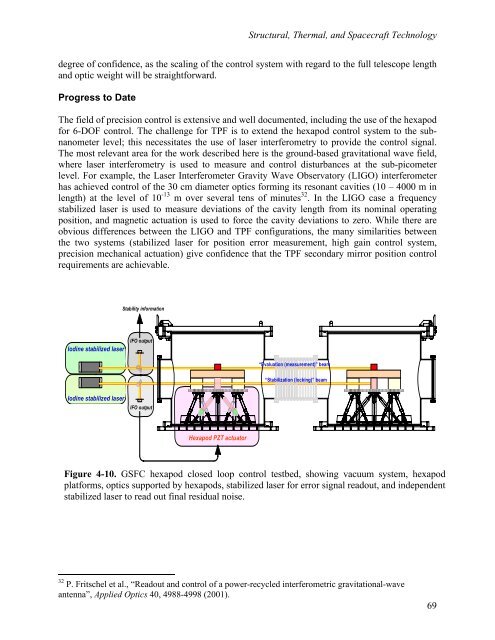TPF-C Technology Plan - Exoplanet Exploration Program - NASA
TPF-C Technology Plan - Exoplanet Exploration Program - NASA
TPF-C Technology Plan - Exoplanet Exploration Program - NASA
Create successful ePaper yourself
Turn your PDF publications into a flip-book with our unique Google optimized e-Paper software.
Structural, Thermal, and Spacecraft <strong>Technology</strong><br />
degree of confidence, as the scaling of the control system with regard to the full telescope length<br />
and optic weight will be straightforward.<br />
Progress to Date<br />
The field of precision control is extensive and well documented, including the use of the hexapod<br />
for 6-DOF control. The challenge for <strong>TPF</strong> is to extend the hexapod control system to the subnanometer<br />
level; this necessitates the use of laser interferometry to provide the control signal.<br />
The most relevant area for the work described here is the ground-based gravitational wave field,<br />
where laser interferometry is used to measure and control disturbances at the sub-picometer<br />
level. For example, the Laser Interferometer Gravity Wave Observatory (LIGO) interferometer<br />
has achieved control of the 30 cm diameter optics forming its resonant cavities (10 – 4000 m in<br />
length) at the level of 10 -13 m over several tens of minutes 32 . In the LIGO case a frequency<br />
stabilized laser is used to measure deviations of the cavity length from its nominal operating<br />
position, and magnetic actuation is used to force the cavity deviations to zero. While there are<br />
obvious differences between the LIGO and <strong>TPF</strong> configurations, the many similarities between<br />
the two systems (stabilized laser for position error measurement, high gain control system,<br />
precision mechanical actuation) give confidence that the <strong>TPF</strong> secondary mirror position control<br />
requirements are achievable.<br />
Stability information<br />
Iodine stabilized laser<br />
IFO output<br />
“Evaluation (measurement)” beam<br />
“Stabilization (locking)” beam<br />
Iodine stabilized laser<br />
IFO output<br />
Hexapod PZT actuator<br />
Figure 4-10. GSFC hexapod closed loop control testbed, showing vacuum system, hexapod<br />
platforms, optics supported by hexapods, stabilized laser for error signal readout, and independent<br />
stabilized laser to read out final residual noise.<br />
32 P. Fritschel et al., “Readout and control of a power-recycled interferometric gravitational-wave<br />
antenna”, Applied Optics 40, 4988-4998 (2001).<br />
69
















